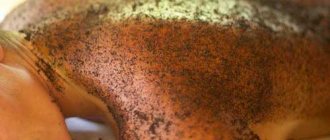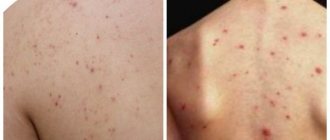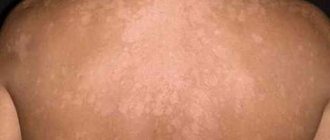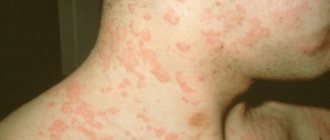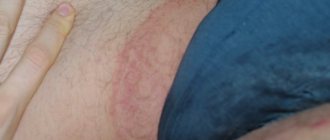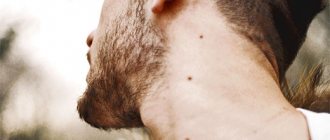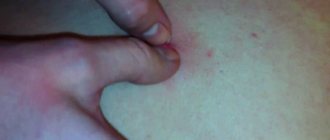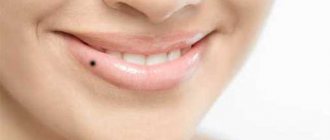Demographic (mechanical) urticaria is one of the most common types of this type of skin disease. The pathology got its name because of its prevalence. In medicine, the term dermographic is used for this urticaria. This is explained by the manifestations of the disease in the form of white or red marks and scars, and accompanying swelling and redness. Translated from Greek, dermographism means “writing on the skin.”
Classification of pathology
Demographic urticaria is classified according to several principles. Depending on the form it is:
- primary (development occurs directly due to the influence of provocateurs);
- secondary (due to the effects of internal diseases present in the body).
Depending on the speed of reaction, the disease is divided into:
- immediate type (appears on the skin 2 to 5 minutes after exposure to the irritating factor and lasts about 30 minutes);
- medium type (the development of edema and irritation occurs in the interval from 30 minutes to 2 hours and lasts up to 9 days);
- late type (less common and appears on the skin after 4 – 6 hours lasting 2 – 3 days).
With all three types of urticaria, a clear sequence of changes in the skin is observed. Initially, exposure to a physical stimulus occurs. Next, redness, swelling and the formation of edema occurs, which grows and increases.
In the middle and late type, the disease manifests itself in those areas that have been under strong mechanical influence for a long time (for example, from the strap of a bag on the shoulder).
Based on the type of reaction, the disease is divided into:
- local dermographism, determined by skin manifestations only in areas of irritation;
- reflex type, in which skin changes after exposure to an irritant appear after a few seconds in the form of a red mark and are a typical vasomotor reflex.
Depending on the manifestation, there are several types of mechanical urticaria:
- Red. Red or bright pink stripes appear on the skin, resulting from strong impact with a blunt, hard object. This type of urticaria is associated with the process of capillary dilation and is more common on the upper part of the body.
- White. When you press lightly for a short time, white stripes appear. This is due to capillary spasm. The disease is more pronounced on the lower extremities and lasts longer compared to the first type.
- Elevated dermographism. Red stripes with uneven contours form, which after a couple of minutes are replaced by white bubbles that swell above the skin and persist for a long time. This is due to the great penetration of the vascular wall.
Symptoms
Any mechanical irritation causes instant production of histamine in the epidermis.
The first symptoms of demographic urticaria can appear on any area of the skin that experiences scratching or pressure.
A symptom is a sign of the manifestation of a disease that distinguishes a sick person from a healthy person, revealed by clinical examination techniques.
You can recognize demographic urticaria by its first and main symptoms:
- instant redness;
- rash.
The rash appears as elongated blisters. Typically, the first rashes form on the skin in the direction of the irritation and always have a linear shape.
Depending on the speed at which the first signs of the disease appear, two types of mechanical allergies are distinguished:
- immediate – the first signs appear immediately after affecting the skin;
- delayed - symptoms occur after prolonged skin irritation only a few hours after the start of exposure.
Symptoms may intensify if the disease is accompanied by psycho-emotional stress. Treatment in such a situation can last a long time.
Read whether urticaria is contagious or not. What is acute urticaria? Click to find out.
Causes of pathology
Demographic urticaria is caused by several factors. This:
- wearing tight clothes;
- carrying heavy bags with a shoulder strap;
- rubbing the skin (with hands during massage, with a washcloth, with a towel);
- scratching (insect bites).
In children who suffer from demographic urticaria, skin manifestations may occur during or after outdoor play.
The main causes of pathology include:
- hereditary predisposition;
- consequences of stress;
- infectious diseases;
- weakened immune system;
- blood transfusion;
- malfunction of the thyroid gland;
- oncological diseases;
- treatment with anti-inflammatory drugs, local analgesics, iodine-containing radiocontrast agents;
- random origin.
Demographic urticaria can act as an independent disease or as a concomitant symptom of another disease.
This type of urticaria can be caused by various factors: taking medications, wearing uncomfortable clothes, and much more.
Description of the disease
Epidemiological features of urticaria
Urticaria is a common disease worldwide that is more common than reported.
Every third person has had symptoms of acute urticaria at least once in their life.
The average prevalence of urticaria is 0.05-0.5%
The chronic form occurs in 10% of cases, most often it is detected in women 30-40 years old - about 30%.
Among children and adolescents – 2.1-6.7%.
The disease does not depend on age, but mainly manifests itself between the ages of 23 and 40 years.
What does urticaria look like in children and adults: photo
It is traditionally believed that chronic urticaria is rare at an early age, although recent studies in Russia indicate the opposite.
Patients with atopy have an increased likelihood of developing acute urticaria. 16.2% of children with atopic dermatitis under the age of 3 years have symptoms of urticaria, and 50% of children with acute urticaria have manifestations of other allergic diseases.
Although urticaria is equally likely to affect both an adult and a child, due to accelerated metabolism and increased activity of the sweat glands, childhood urticaria develops faster and is more severe.
What causes hives
At-risk groups:
- People prone to allergies and atopic dermatitis in particular;
- Small children under 2-3 years old;
- Women have an increased risk of developing a disease due to nervousness.
The following are the main risk factors that can trigger the disease:
| Factor | Description |
| Medicines | One of the most common reasons. The reaction can be caused by antibiotics (penicillin, sulfur-containing), painkillers (aspirin, ibuprofen). Sometimes hives may appear after completing a course of medication |
| Food (food urticaria) | Sometimes a reaction to certain foods can manifest itself in the form of acute urticaria. Products:
|
| Insect bites and stings | They often cause an acute form of the disease (especially wasp and bee stings). The rash persists for quite a long time. |
| Contact with certain substances | These could be: household chemicals, animal hair, |
| Contact with plants | In this case, contact dermatitis initially occurs, which, if not properly treated, can develop into urticaria. |
| Physical urticaria | Called by a specific physical. impact:
There is also the concept of urticarial dermographism as a reaction of the skin to mechanical stress, after which persistent protruding stripes appear on it |
| Bacterial and viral infections | These types of diseases increase the likelihood of hives |
| Emotional state, stress | A fairly common cause of urticaria. |
| Other | In the vast majority of cases, the causes of urticaria remain unknown. It is assumed that urticaria in this case is of an autoimmune nature |
Symptoms
Demographic urticaria is characterized by:
- itching, worse at night;
- burning, pain and swelling of the pathological area;
- the presence of scars in the form of straight lines of a light shade, which are surrounded by areas of color ranging from pale red to burgundy;
- deterioration in general health;
- in some cases, increased body temperature;
- worsening of symptoms due to exposure to high temperatures (taking a hot bath, visiting a sauna).
Demographic urticaria rarely occurs over large areas of the skin surface. It also practically never appears on the surface of the head and genitals.
Under the influence of objects, quickly disappearing stripes of white color appear on the skin of a healthy person. In a demographic patient with urticaria, such provocation results in an inflamed red scar with a white central part. Symptoms of the pathology appear within a few minutes after the influence of the irritating factor.
Important! Demographic urticaria in a mild form can pass without characteristic signs and subside within a couple of days. The duration of the disease in severe form can range from several months to several years.
Diagnostic test
To accurately determine whether urticaria is caused by a mechanical irritant, the doctor performs a dermatographic test. Strokes are applied to the skin of the forearm with a blunt, hard object (medical spatula). In a healthy person, whitish stripes first appear, which quickly turn red and disappear on their own after a few minutes. With dermatographic urticaria, the impact marks are intensely red and swell, rising above the skin level. The process is accompanied by severe itching.
Diagnosis
If signs of urticaria appear, you should contact a therapist, allergist-immunologist and dermatologist. Based on the symptoms of the disease, the doctor can easily make a diagnosis. To identify more accurate information, the specialist conducts a survey about the first appearance of urticaria, the duration and frequency of its occurrence. The following information is also analyzed:
- working conditions (contact with provoking substances);
- eating a new type of food;
- have recently suffered from illness;
- taking medications.
Prescribing appropriate treatment requires an accurate determination of the type of urticaria and the cause of its occurrence. To identify the type of allergen, additional examination is carried out:
- Visual inspection. It includes an examination of the skin to exclude other types of dermatological pathologies. It is important to consider the parameters of the lymph nodes to exclude chronic causes of pathology.
- Laboratory tests (complete blood count, urine test, stool test, ESR determination, skin surface biopsy, liver tests).
- Skin tests. They are carried out to accurately diagnose the type of urticaria.
If required, the patient is referred to an appointment with specialized specialists (gastroenterologist, parasitologist, endocrinologist, immunologist).
A set of research data will make it possible to correctly diagnose the type of demographic urticaria and prescribe therapy appropriate to a specific case.
Diagnostics
Attention ! If you suspect you have dermographic urticaria, consult your doctor . Treatment should be started immediately to prevent the disease from getting worse.
The diagnosis is made by a dermatologist or allergist (immunologist).
The doctor examines the patient's skin and then performs a small skin test to check the reaction to impact with a blunt object; in patients with dermographism, a characteristic scar immediately forms at the contact site (if cholinergic dermographism is suspected, the test is performed using an ice cube).
Next, the patient is prescribed a series of tests :
- culture for pathogenic intestinal flora and analysis for worms (to exclude bacterial infection);
- general blood analysis;
- analysis of thyroid hormones;
- immunity test.
Treatment options
After studying the diagnostic results and identifying the cause of the disease, the attending physician prescribes appropriate treatment. Initially, all skin irritating factors are neutralized and an H1 antihistamine (Cetirizine, Zyrtec and others) is taken once. This drug selectively affects the activity of histamine. Itching is relieved with a cold or chamomile compress. This treatment is aimed at relieving symptoms. Improvement occurs within a few days. Red welts may remain on the skin surface for several months.
If there is no effect from H1 drugs, drugs of group H2 (Tagamet, Bricanil and others) are used. They selectively bind to histamine H2 receptors and block its functioning. Often these drugs H1 and H2 are prescribed in combination.
When antihistamines do not work, other treatment methods are used:
- taking oral steroids;
- UV radiation;
- taking antidepressants.
To relieve itching, inflammation, irritation, and redness, special ointments and gels are used (Fenistil gel, Nezulin, Drapolen cream and others).
Important! The treatment regimen for demographic urticaria and the duration of treatment should be prescribed directly by the attending physician. Self-medication is unacceptable.
Treatment of urticaria in children and adults
In most cases, urticaria does not require treatment and goes away on its own after some time.
Treatment of acute forms should be comprehensive and include: drug therapy, diet therapy, and elimination measures.
Tablets, ointments and other products
The following groups of drugs are used:
- Systemic steroids are the most powerful group that suppresses the immune response. Injection and external forms are used (Diprospan, Advantan, Akriderm).
- Antihistamines - have a significant anti-inflammatory effect, especially 3rd generation antihistamines for urticaria (Desloratadine), 1st and 2nd generation antihistamines (Xizal, Suprastin, Tavegil, Fenistil, Erius);
- Leukotriene receptor antagonists (Zafirlukast).
- Immunomodulators – increase the body’s resistance (Galavit).
- Sorbents (Enterosgel, Polysrob).
- Desensitizing agents (calcium gluconate).
- Local anti-inflammatory agents (Zinc ointment).
It is worth highlighting plasmapheresis as a mechanical method of eliminating allergens from the body.
First aid for a child in the event of an acute form of urticaria should include the first three groups of drugs.
Lecture by P.V. Kolhir “New perspectives in the diagnosis and treatment of urticaria and angioedema”
Treatment of urticaria with folk remedies
Treatment of urticaria with folk remedies is not recommended for its acute and widespread form.
Itching Relief Products
The best local remedy is a cold compress on the affected area of the skin. This procedure helps to constrict blood vessels and reduce the production of histamine - this in turn reduces swelling, relieves inflammation and itching.
- Wrap the ice cubes in a cloth. Place on affected areas of skin for 10 minutes. 3-4 times a day;
- A cool shower or bath has a similar effect.
Note: Never place ice directly on your skin.
Baking soda
It is another popular remedy for hives. Its anti-inflammatory properties help reduce inflammation and relieve itching.
- Add 0.5 - 1 cup of baking soda to a bathtub filled with warm water. Stir well and take for 20-30 minutes.
- Alternatively, mix 2 tbsp in a bowl. l. baking soda with warm water until you get a thick paste. Apply the paste to the affected area and leave for 10 minutes. Afterwards, rinse with warm water.
Apple vinegar
It will also help reduce inflammation and restore healthy skin faster.
- Add two cups of vinegar to a bathtub filled with warm water. Take it for 15 – 20 minutes once a day.
- Alternatively, dilute apple cider vinegar with an equal amount of water and wash the affected skin 2-3 times a day.
- You can also mix 1-2 teaspoons of vinegar in a glass of water. Add a little lemon juice and honey to improve the taste. Drink three times a day.
Oatmeal
It has anti-inflammatory and soothing properties - will soothe itching and help the skin heal quickly.
- Mix 1 tbsp. baking soda and 2 tbsp. oatmeal. Add this mixture to a bath filled with warm water. Stir well and take a bath for 15 minutes. Enjoy this soothing treatment 2 times a day until your condition improves.
- Mix 2 tbsp. oat flour, 2 tbsp. l. cornstarch and enough water to form a thick paste. Apply the paste to the affected areas of the skin and leave for 15 – 20 minutes. Rinse off with warm water. Use this remedy once a day.
Nettle
An effective folk remedy, it has astringent, blood purifying and anti-inflammatory properties.
Add 1 tbsp. l. dried nettle leaves into a glass of hot water. Cover and brew for 10 to 15 minutes. Strain and add a little honey. Drink tea 2-3 times a day until the condition improves.
Aloe vera
Safe, easily accessible and effective. You can use it without worrying about overdosing.
Take a thick aloe leaf, peel off the skin and apply the gel to the affected areas.
This treatment will help cool the skin and reduce swelling and itching. In addition, Aloe gel creates a protective film on the skin, has antifungal and antibacterial properties, which will help avoid infection if you scratch your skin too much.
Sedatives
Stress is one of the causes of hives. You should take tinctures and decoctions of herbs that have sedative properties: valerian, hawthorn, chamomile, mint.
Features of nutrition and lifestyle with urticaria
For this disease, a hypoallergenic menu is indicated (table No. 5), which provides for normal consumption of carbohydrates and proteins, with some restrictions on fats.
Read more about the diet for urticaria on our portal – //allergy-center.ru/dieta-pri-krapivnitse.html
Forecast and preventive measures
Demographic urticaria is a treatable disease. With proper therapy, a positive result will be noticeable within the next few days. Only in 8% of cases, demographic urticaria becomes chronic. But this happens only due to a disturbed psycho-emotional state.
To prevent the disease, certain preventive actions should be followed. These include:
- exclude allergic foods from the diet;
- maintain a daily routine;
- lead a healthy lifestyle;
- wear comfortable clothes (not squeezing or touching pathological areas of the skin);
- do not wear woolen or synthetic items;
- observe the temperature regime in the room and avoid temperature changes;
- sleep in ventilated and cool rooms;
- avoid stressful situations.
Doctors recommend that people who have treated dermatological urticaria undergo a re-examination to confirm the result. In rare cases, after attenuation, the disease returns. Only a responsible attitude towards one’s health will help protect a person from many diseases, as well as preserve youth and beauty for many years.
Treatment prognosis and possible complications
Dermographic urticaria is not a dangerous disease and does not lead to serious consequences or complications. In some situations, if the provoking factor was stress, then after a week there is no trace of the disease. In rare cases, patients may become infected by scratching the inflamed skin. In the case of a chronic form, this type of urticaria can occur frequently and treatment only helps to reduce the severity of symptoms.
Despite its safety and lack of complications, dermographic urticaria can be uncomfortable for patients
Navigation
- What factors cause urticaria?
- How to treat hives
This rash appears spontaneously: multiple light pink, flat-raised blisters form on the surface of the skin. These blisters are very itchy and look like a rash from a nettle burn (in fact, this is where the name comes from). If you press on the blister, it will turn pale.
Urticaria is considered to be a symptom, a consequence of the influence of certain factors, rather than an independent disease. For example, in some people it manifests itself as a consequence of some autoimmune pathology, bronchial asthma.
As an independent allergic disease (reaction), without the presence of accompanying symptoms, urticaria also sometimes occurs, but rarely. The most common complications of urticaria are angioedema and bacterial infections due to scratching the skin.
Urticaria is a very common occurrence. According to statistics, every third person has suffered this condition at least once in his life. Women develop urticaria approximately more often than men.
Causes
When mechanical urticaria appears, the cause most often remains unknown , but some factors can make a negative contribution to the development of the disease.
Causes of demographic urticaria:
- Histamine , released by mast cells onto the surface of the skin, is the most common cause of hives. Histamine is released in the absence of antigen and as a result of weakening of the membrane enveloping mast cells (due to the patient's weak immunity). Swelling of the skin is caused by the release of histamine.
- Allergic reactions to certain medications, such as penicillin, can initiate the disease.
- Mechanical impact . Pressure, insect bites, scratching the skin, injections.
- Infection . Helicobacter pylori, a gram-negative bacterium that commonly causes gastric ulcers and digestive tract diseases, can lead to the development of dermophographism.
- Genetic factor . Urticaria is considered a hereditary disease that is transmitted in an autosomal dominant manner.
- Thyroid dysfunction.
- Emotional stress and heavy physical activity .
What factors cause urticaria?
For a certain number of episodes, the precipitating factor, as a rule, remains unidentified. If it happens that after passing various tests and all the necessary examinations the cause is not found, a diagnosis of “idiopathic urticaria” (that is, chronic) is made.
Thus, the course of urticaria can be different: chronic and acute. The main mediator that causes the development of the disease is histamine, which is formed and accumulates in mastocytes. The periodic release of histamine into surrounding tissues and into the blood is provoked by a number of factors. By the way, the itching of the affected areas of the skin is explained precisely by the release of histamine, which irritates the nerve endings.
The main factors that provoke chronic urticaria are:
- viral or bacterial inflammatory diseases such as caries, adnexitis, cholecystitis, etc.;
- disturbances in the functioning of the immune system, in 20% of cases become “that push”: the body begins to attack its own cells, mistaking them for strangers - accordingly, we are talking about autoimmune urticaria;
- allergic reactions to certain foods, medications: as a rule, allergic urticaria (dekaclinic.ru/allergicheskaya-krapivnica) almost always implies associated factors (chronic processes);
- exposure to external allergens (plant pollen, dust, animal hair, etc.);
- physical phenomena, for example, hot sun, cold, water (aquagenic urticaria);
- mechanical irritation, injury (scratching, friction of a belt or tight clothing, etc.)—demographic urticaria;
- insect bites;
- a sudden increase in body temperature associated with heavy physical activity, nervous overexcitation, or ingestion of excessively spicy or hot food.
From the above it is already clear that there are different types of urticaria: allergic, autoimmune, cold, contact, vibration, demographic, etc. In fact, cold, contact, aquagenic, and food urticaria are allergic, since we are talking about a special reaction to external irritants.
Is it possible to swim if you have hives?
Due to the fact that this disease is characterized by allergic manifestations, it is believed that bathing can provoke adverse reactions on the skin. But, despite this, to the question: is it possible to wash with hives, doctors answer in the affirmative. This is also due to the fact that completely abandoning water treatments during illness can cause the rash to become infected. It can lead to serious complications and suppuration.
People suffering from this disease should regularly carry out hygienic procedures by washing. The only condition is compliance with the rules.
Basic recommendations to follow:
- Warm water should be used for washing, within 37 degrees (this will help prevent increased itching and further progression of the rash. During the entire phase of exacerbation of the disease, contact with both hot and cool water should be avoided)
- You should take a bath once a week, and you can use a shower daily (water exposure time should be limited to 20 minutes)
- Products used for hygiene should not provoke allergic manifestations (the optimal solution in this situation is the use of special body products, developed taking into account all the characteristics of the disease. They are hypoallergenic, have an antibacterial and anti-inflammatory effect)
- You should avoid exposure to washcloths and scrubs.
- After the procedure, you need to dry the skin thoroughly, blotting it with a clean towel (using rubbing is strictly prohibited!)
- After a shower, apply a nourishing, softening cream to the skin.
Experts also note the good effect of sea water on the patient’s skin. It helps in relieving itching and irritation, and disappearing rashes. But before you go swimming in the sea, you should consult your doctor. He will give the necessary recommendations based on the diagnosed type of urticaria. Also, exposure to sea water is often prohibited during an exacerbation period.
Patients often ask: “Is it possible to go to the bathhouse if you have hives?” The answer to this question depends on the factors that caused the disease. In cases where the disease was provoked by medications or physical factors, visiting the bathhouse is allowed. For other types, such visits should be canceled for a while. To carry out water procedures in the bathhouse, it is recommended to use various infusions that have antipruritic and antiallergic properties, for example, using nettle and chamomile.
The collected information fully answers the question: what is urticaria and how to treat it? After studying it, you should carefully monitor your health and detect signs of disease in time and seek help from a doctor.
How to treat hives
In adults, the disease in most clinical cases has a chronic form. When all the symptoms of urticaria are observed, treatment should be comprehensive:
- Elimination of irritating factors (for example, allergens) and taking antihistamines;
- taking desensitizing drugs;
- multivitamin therapy;
- following a “hypoallergenic” diet;
- taking absorbents and diuretics;
- proper hygiene and skin care;
- taking hormonal medications (in severe cases);
- Possible physical therapy.
Treatment of mechanical urticaria
Drug therapy for urticarial dermographism is aimed at eliminating the symptoms of the disease that bother the patient and strengthening the body's defenses.
To reduce the concentration of histamine and get rid of rash, swelling and redness, the following antihistamines are prescribed:
- Claritin;
- Allegra;
- Telfast;
- Zyrtec;
- Cetrin;
- Erius;
- Tavegil.
External application of antiallergic ointments is also recommended:
- Fenistil gel;
- Psilo balm;
- Desitin;
- Bepanten;
- Zinc ointment.
If the disease is chronic, when the use of antihistamines does not have the expected effect, drugs containing glucocorticosteroids are used: injections of Prednisolone or Dexamethasone, hormonal ointments Advantan, Flucinar, Laticort.
To strengthen the immune system, taking vitamin complexes Duovit, Trivit, Multitabs is recommended. To strengthen the walls of blood vessels, flavonoids are prescribed - Ascorutin, Rutin, vitamin P.
An important component of therapy for all types of urticaria is a hypoallergenic diet, which excludes the consumption of foods that can trigger allergies. It is necessary to follow a special diet not only during treatment, but also for at least 3 weeks after the symptoms of the disease disappear.
To eliminate the initial manifestations of urticaria, you can use folk remedies that are easy to make at home. The most effective against rashes and swelling are:
- compresses from finely grated raw potatoes;
- baths with decoctions of nettle, string, celandine, chamomile, calamus;
- lotions with oak bark infusion;
- applications from a baking soda solution.
Since many medicinal plants are strong allergens, the use of folk remedies must be coordinated with your doctor.
Demographic or dermatographic? Definition of disease
To understand which name is correct, it is enough to run any blunt object over the body of a person suffering from this disease. Immediately or after some time, stripes will swell on the skin, accurately repeating the trajectory of the applied pattern. This symptom served as the basis for the name of the disease: dermatographic, from the words “derma” - skin and “graphics” - to draw, write.
In medical circles, this disease is also called urticarial dermographism (from the word “urtica” - blister), autographism or mechanical urticaria. The name “demographic” is common and incorrect because it does not reflect the essence of the disease.
Autographism accounts for a tenth of all cases of urticaria. The risk group includes people who have a hereditary predisposition to allergies or suffer from other types of urticaria - solar, cold, food, medicinal.
Photos of symptoms
The photos below show the symptoms of dermatographic urticaria - characteristic swollen stripes on the skin, white and red blisters that occur after pressure or other mechanical impact.
What is dermographic urticaria
The term "dermographic" consists of two words. The first dermis means skin, the second word is graphics - draw, designate. It is the combination of these two words that explains the external features of the disease - various lines and patterns appear on the body, matching the shape of the mechanical stimulus.
Dermographism in a broad sense is a local reaction of blood vessels located in the skin in the form of stripes of a red or whitish hue. Changes in skin color are associated with spasm or, conversely, expansion of veins and arteries in response to mechanical irritation.
Dermographic urticaria is a condition in which symptoms characteristic of allergic skin reactions appear - itching, redness and blisters.
Separately, a simple type of dermographism is distinguished. This is a condition in which, under the influence of strong or moderate mechanical stress, blisters and areas of redness appear on the body, but there is no itching.
Simple dermographism is associated with a hyperreaction of the skin; all symptoms disappear over time and no treatment is required.
DC is one of the forms of induced urticaria. The last term refers to the reaction on the body that occurs to physical factors - water, pressure, cold.
Dermographism is a consequence of mechanical irritation of the superficial layers of the skin. Most often, the disease appears at a fairly young age; pronounced manifestations persist on average for 5-6 years; most patients experience spontaneous recovery.
In medicine, dermographic urticaria is also referred to as urticarial dermographism, mechanical urticaria or autographism.
The risk group for the development of pathology includes people with other forms of induced urticaria - cold, food, sun.
What causes the disease
The main reason for the appearance of dermographism in urticaria is the release of a large amount of histamine into the blood, a biologically active substance that causes allergies. The stimulating factor is a mechanical effect (pressure, vibration, shock) on mast cells located in the subcutaneous layer, in which histamine is produced. As a result, the permeability of the vessel walls increases, blood stagnates in the capillaries and edema occurs.
After numerous studies, it has been established that most often cases of urticarial dermographism occur in people with a history of the following factors:
- presence of a predisposition to allergies in parents or other relatives;
- past viral diseases;
- post-stress state;
- diseases of the endocrine system;
- HIV;
- malignant tumors;
- poisoning with salts of heavy metals, ethanol and other chemicals.
Dermatographic urticaria can be idiopathic in nature and result from self-hypnosis or excessive emotionality of the patient.
With autographism, redness, swelling and blisters may appear in the following cases:
- when slapping or hitting the skin with a hand, cloth or other object;
- when pressed by the straps of bags, backpacks, watch bracelets, belts, belts, elastic bands of stockings and socks, etc.;
- when rubbing against the body of clothing (especially rough seams);
- when washing with a hard washcloth or brush;
- when scratching the site of an insect bite;
- after cycling (on the inner thighs);
- when sitting for a long time on a hard chair (on the buttocks);
- after a long walk (on the feet).
Sometimes dermatographic urticaria is a consequence of severe autoimmune diseases: systemic lupus, myasthenia gravis, multiple sclerosis and others. To identify this and begin treatment on time, it is necessary to consult a dermatologist or allergist when the first signs of the disease appear.
Causes and development factors
Currently, the reasons for the formation of dermographic urticaria are not yet fully understood. It is believed that this disease is multifactorial and various causes can affect its occurrence. In some cases, the hereditary nature of the disease is proven, since children whose parents have urtical dermographism have a higher chance of being diagnosed with this disease.
In some situations, the appearance of this type of urticaria may be affected by:
- nervous tension, stress;
- endocrine disorders;
- viral diseases;
- problems with the digestive system;
- infection with worms;
- blood transfusion;
- benign and malignant tumors;
- the body's reaction to certain medications.
However, in most cases the disease is idiopathic in nature, since the cause of its occurrence remains unclear.
The very mechanism of the occurrence of rashes is the activation of mast cells (mast cells), which begin to intensively secrete various substances, including histamine. Due to its effect on the body, arterioles expand, the walls of blood vessels become more permeable, fluids from surrounding tissues begin to be absorbed more quickly, and edema forms on the surface of the skin where the mechanical effect occurred. The receptors are also irritated and patients sometimes complain of itching. Cells are sent to the site of edema, forming an inflammatory process.
Mast cells contain granules containing histamine, which are released during degranulation and enter the body.
Currently, the mechanism of activation of mast cells remains unknown. There are hypotheses that due to various genetic factors or metabolic disorders, a deviation in the structure of their membrane occurs. Because of this, mast cells degranulate, which is normally a protective mechanism. However, in dermographic urticaria, this process leads to pathological skin reactions.
Some experts put forward a hypothesis about the reactivity of body tissues. Normally, all people experience activation of mast cells under mechanical stress, but only a small number of them develop abnormal rashes. The amount of histamine released is so small that it cannot lead to such a strong reaction in a healthy person. Patients with dermographic urticaria have an increased sensitivity to this substance and even its small release from mast cells provokes urticaria. Based on this assumption, it is not a matter of disturbances in the process of mast cell degranulation, but of the susceptibility of individual patients to histamine. In some cases, both mechanisms provoke the disease.
Characteristic symptoms
Urticarial dermographism can be distinguished from other forms of urticaria by the whitish, pink or bright red stripes that appear at the site of exposure to the irritant. Other signs common to all types of urticaria include:
- skin redness;
- swelling;
- feeling of skin tightness;
- burning;
- papular rash.
In addition, the disease may be accompanied by the following symptoms:
- headache;
- dizziness;
- general weakness;
- increased body temperature;
- chills;
- nausea.
It has been noted that dermatographic urticaria is practically not accompanied by itching, so patients do not experience scratching, which is characteristic of other types of the disease.
Classification of dermatographic urticaria
In dermatology, there are several classification systems for mechanical urticaria based on various characteristics.
Based on the speed of reaction to a stimulus, the following types are distinguished:
- instant. Symptoms of the disease appear within 3-5 minutes and persist for half an hour;
- average. The appearance of blisters and swollen stripes is observed after 30-60 minutes and continues for 4-10 hours;
- long-term Signs of urticaria may appear only after 5-7 hours and last for several days.
The last type of disease is considered the rarest.
Depending on the clinical manifestations, dermatographic urticaria is:
- white. After pressing on the skin, a spasm and narrowing of the capillaries occurs, resulting in the formation of a white mark protruding 2-3 mm above the surface. Disappears after 3-5 minutes;
- red. When a blunt object is passed over the body, a slap, or a blow, a red mark is left that lasts up to several hours;
- swollen or elevated. After mechanical impact, the skin turns red and then swells with white, voluminous blisters, which may not go away for up to 2 days.
In addition, a distinction is made between local dermographism, in which swollen stripes and a rash appear directly at the site of pressure or impact, and reflex, when symptoms also affect nearby areas of the skin.
What is demographic urticaria?
demographic urticaria
Urticaria is a certain reaction of the human skin, which manifests itself in the form of a rash and consists of convex or flattened formations of a reddish hue, causing itching.
The main distinguishing feature of the disease in question is that it appears completely suddenly. Also, urticaria, both in the younger generation and in mature people, can periodically disappear and then reappear. Many diseases, for example, cutaneous mastocytosis or urticranial vasculitis, are very similar in their symptoms to urticaria, but for some time now medicine has not classified them as varieties of this disease, distinguishing them as independent. In medicine, there are several types of urticaria. All of them can be divided into two main groups: spontaneous (ordinary) and physical (also called mechanical) urticaria. The latter type, in turn, consists of subspecies. One of these subtypes is demographic urticaria.
One of the most common types of physical urticaria is demographic. This disease affects two to five percent of the world's population. But it should be noted that for most of them it does not cause serious inconvenience or suffering. The demographic type of urticaria accounts for seven to thirteen percent of cases among all chronic forms of this disease.
This type of hives occurs because histamine is released by mast cells. True, science still does not know the mechanism by which such cells release histamine from minor stroke effects. There is a belief that this can happen under severe psycho-emotional stress.
The duration of this disease usually ranges from two to three years. There is also secondary demography, which occurs in different ways, depending on the presence of various etiopathogenetic factors.
This disease makes itself felt in the following way: a rash appears in the area that is scratched and itching begins. The clinical picture of this type of urticaria can be observed if a person’s skin is irritated with great intensity with linear objects.
If you run a long fingernail over the skin of a healthy person, you will find a white line on it, which after a while will turn red and a small tumor will be observed at the site of scratching. This all speaks about the reaction of healthy skin, but if scars appear on the mark, then this is demography.
It will manifest itself from a variety of influences, for example, from pressure on the skin surface of furniture, towels, tight clothing, and even from the tight hugs of other people. Clinically, there are several subtypes of dermographism: cold-dependent dermographism, follicular dermographism, white dermographism and red dermographism.
Dermographic urticaria can be found on any part of the skin of a person suffering from this disease, but most rarely they appear on the limbs and face of the patient. Primary forms of dermagraphic urticaria can be divided into allergic and idiopathic.
As for secondary forms, they are associated with a number of other diseases, such as viral infection, serum sickness or mastocytosis. There is a possibility that people have a familial form of dermographism - this is the so-called autosomal dominant type of inheritance. Treatment for this disease depends on its severity.
Thus, a mild form of the dermographic variety of urticaria does not require any targeted treatment of the patient at all. Very often you can get by by taking antihistamines once in the evening, the dosage of which directly depends on the age of the patient.
The time of taking various drugs and their quantity are determined by the daily severity of the symptoms of dermographism. Among the general recommendations, doctors advise patients to avoid direct contact of their skin with things made from natural wool.
Even in the room of a person suffering from the demographic variety of urticaria, a sufficiently cool temperature should be ensured during night sleep.
If a patient has an acute form of this type of urticaria, then he should exclude from his daily diet only those foods whose connection with this disease is suspected by the patient or the doctor himself, or if there is evidence of this connection, substantiated by scientific research.
In the future, after all the symptoms of the disease have disappeared, these restrictions can be revised, if necessary, additional tests can be taken, but in all other cases, there is no advisability in restricting the diet.
It is also important to note that patients with both acute form of urticaria and in case of exacerbation of chronic form of dermographism need to exclude from their diet the consumption of alcoholic beverages of any strength, even in the smallest quantities. This disease can be accompanied by severe angioedema, skin rashes and itching.
Based on this, in no case should you resort to self-medication for urticaria. At home, dermophragism can be treated only after the patient has been examined by a specialist. The fact is that your already mentioned angioedema can potentially lead to a fatal outcome. It requires special professional knowledge to help cure it.
In other words, treatment of the demographic variety of urticaria, as well as its other types, at home can be carried out only after a face-to-face consultation with an allergist, who will suggest a regimen for the use of antihistamines or other drugs, and in addition, he will approve a further plan for observation and diagnostic measures.
Source: logderma.ru
Treatment
If, as a result of the diagnostic measures carried out, it is established that dermatographic urticaria occurs against the background of a chronic disease, then it must be cured first. In general, the mechanism for eliminating the symptoms of autographism does not differ from the treatment of other forms of urticaria and includes the following components:
- taking antihistamines;
- use of external antiallergic agents;
- the use of drugs to eliminate general symptoms;
- folk remedies.
Antihistamines
For uncomplicated forms of urticarial dermographism, first-generation antihistamines are prescribed to eliminate redness, skin rashes, swelling and itching:
- Diphenhydramine;
- Suprastin;
- Tavegil;
- Diazolin;
- Fenkarol.
Having a quick effect, these medications help get rid of the symptoms of urticaria in 3-4 days. The disadvantage of first generation antihistamines is the large number of side effects that make their use impossible if urticaria is diagnosed in a child or a pregnant woman.
In the case of chronic recurrent urticaria, it is more advisable to resort to second or third generation antihistamines. These include the following tablets and syrups:
- Clarotadine;
- Kestin;
- Claritin;
- Rupafin;
- Zyrtec;
- Gismanal;
- Desal;
- Xizal;
- Erius.
These drugs have a prolonged effect, so they need to be taken once a day. Claritin and Zyrtec can be used during pregnancy, but only under the supervision of a physician for a short time. Desal and Erius in syrup form are used in pediatric practice. Contraindications are problems with the cardiovascular system and chronic liver diseases.
In the absence of the expected result from the use of these medications, as well as in severe cases of the disease, hormonal medications are used - Prednisolone, Dexamethasone.
External antiallergic agents
You can reduce the unpleasant symptoms of dermatographic urticaria using external medications. For mild manifestations of the disease, non-hormonal ointments are recommended:
- Fenistil-gel;
- Psilo-balm;
- Bepanten;
- Desitin.
They can be safely used by patients with sensitive skin, as well as for the treatment of small children and pregnant women.
For extensive lesions or insufficient effectiveness of non-hormonal agents, ointments containing corticosteroids are used:
- Prednisolone;
- Hydrocortisone;
- Dermovate;
- Elokom;
- Flucinar.
It is important to remember that hormonal drugs have many contraindications and can lead to serious consequences. Therefore, they should be used exclusively as prescribed by a doctor in the prescribed dosage.
Medicines to relieve general symptoms
You can get rid of non-allergic manifestations of urticaria and the causes that can cause the disease using the following medications:
- Paracetamol, Fanigan, Ibuprofen - for headaches, sore skin in affected areas;
- Notta, Persen, Novopassit, motherwort tincture - for nervous disorders, stress;
- Belloid, Bellastesin - for stomach pain;
- Cerucal - for nausea.
In addition, to strengthen the body and increase immunity, it is recommended to take vitamin complexes: Multitabs, Decamevit, Trivit, Alphabet and others.
Folk remedies
In the complex treatment of autographism, a significant place is given to folk remedies. The use of herbal preparations helps eliminate the symptoms of the disease - blisters, burning, itching, swelling.
The most popular recipes are:
- Mix the herb, chamomile and motherwort in equal proportions. Pour 2 tablespoons of the mixture into 300 ml of boiling water and leave for 2 hours. Strain the broth and apply to areas of swelling in the form of lotions for 15-20 minutes;
- Pour 300 g of dried and crushed nettle into 2 liters of boiling water and leave in a water bath for 1 hour. Then filter and use for bathing for 25 minutes every day;
- Grate raw potatoes on a fine grater. Pour the pulp onto clean gauze and apply to the blisters for 10-15 minutes.
It should be remembered that medicinal herbs can also be a strong allergen. Therefore, before starting treatment with folk remedies, it is necessary to consult with your doctor.
Treatment methods
Demographic urticaria is a common phenomenon among skin pathologies. It occurs in both children and adults. In this case, the skin is severely injured, becoming susceptible to any irritation.
It is acceptable to wait the first few days and independently take measures to eliminate the symptoms of demographic urticaria. If this does not help, you should contact a specialist who will prescribe the necessary therapy.
In the case of a severe form, treatment may take a long time and require an integrated approach: the use of tablets and ointments, and adherence to a special diet. After a thorough examination and consultation with an allergist-immunologist, special antihistamines are prescribed.
On this topic
- Hives
The best treatments for generalized urticaria
- Olga Aleksandrovna Kalinina
- July 18, 2020
If symptoms are severe and uncomfortable, corticosteroids may also be prescribed. It is important to start treatment in a timely manner so that the disease does not become chronic.
Self-medication for urticaria of high severity cannot be practiced; only a doctor can choose the most effective tactics.
The following steps can be taken as first aid measures:
- Avoid pressure, friction and other mechanical influences on the affected areas of the skin.
- Take any antihistamine . For example, Tavegil.
- Apply a compress to relieve itching. For example, you can soak a cotton swab or gauze in a warm chamomile infusion.
If after a few days the symptoms of hives still persist or worsen, it is worth visiting a doctor.
Drug treatment method
If an allergic reaction occurs, use antihistamines. They help relieve the symptoms of hives by blocking the negative effects of histamine.
Therapy with pharmaceutical drugs
For internal use:
- Cetirizine. Prescribed, including when urticaria has become severe. Apply until the skin recovers. The treatment period is usually 1-2 weeks.
- Zodak. Also helps in the treatment of severe forms. It is a drug that helps suppress histamine H2 receptors. Due to this property, it is suitable for patients who have not had a response from the body to the H1 drug.
- Zyrtec. Therapy usually lasts 1-2 weeks. The drug is taken once a day, before bedtime.
- Claritin. Helps significantly reduce treatment time and relapses.
The required dosages are selected and adjusted by a specialist.
Local products
For treatment, it is important to use combination therapy - not only tablets alone, but also ointments. As already noted, with urticaria an allergic reaction occurs. As a result, scars form on the skin.
Ointments help relieve itching and swelling:
- Fenistil. The product is especially recommended for people suffering from severe urticaria. It is not recommended to use for a long time.
- Nezulin. Helps relieve irritation and itching, alleviating unpleasant symptoms.
- Drapolene (cream). Has a decongestant effect, helps eliminate redness and itching. Fights well against scars.
- gels . Contains natural aloe extract, which relieves irritation.
If the use of antihistamines and special ointments does not help, other treatment methods may be additionally prescribed. For example, therapy with oral steroids and antidepressants. Light therapy is also used.
This type of treatment uses ultraviolet rays. The course is selected depending on the medical history.
The rays that are invisible to humans, which are part of such radiation, can have a healing effect. Melanin synthesis begins to accelerate. This is important because it is responsible for skin pigmentation and vitamin D metabolism.
Prevention
Even people who are prone to allergic reactions can prevent the appearance of symptoms of dermatographic urticaria by following the following preventive measures:
- wear loose-fitting clothes made from natural fabrics without narrow straps, belts, belts or elastic bands;
- do not wear tight socks, stockings and tights;
- avoid products made of rough material with convex seams;
- do not carry backpacks and bags on your shoulders;
- do not use hard sponges, pumice stones, or brushes when washing;
- when working sedentarily, get up every 30 minutes and do a warm-up;
- do not walk for a long time, especially in heels or uncomfortable tight shoes;
- do not resort to hard massage or self-massage;
- do not engage in sports that may involve falls, impacts, etc.
In addition, you need to pay as much attention as possible to your health: give up bad habits, follow a hypoallergenic diet, avoid stress and overly emotional situations. It is also necessary to regularly undergo a medical examination and take all necessary tests in order to promptly identify and treat any disease that may trigger an attack of dermatographic urticaria.
